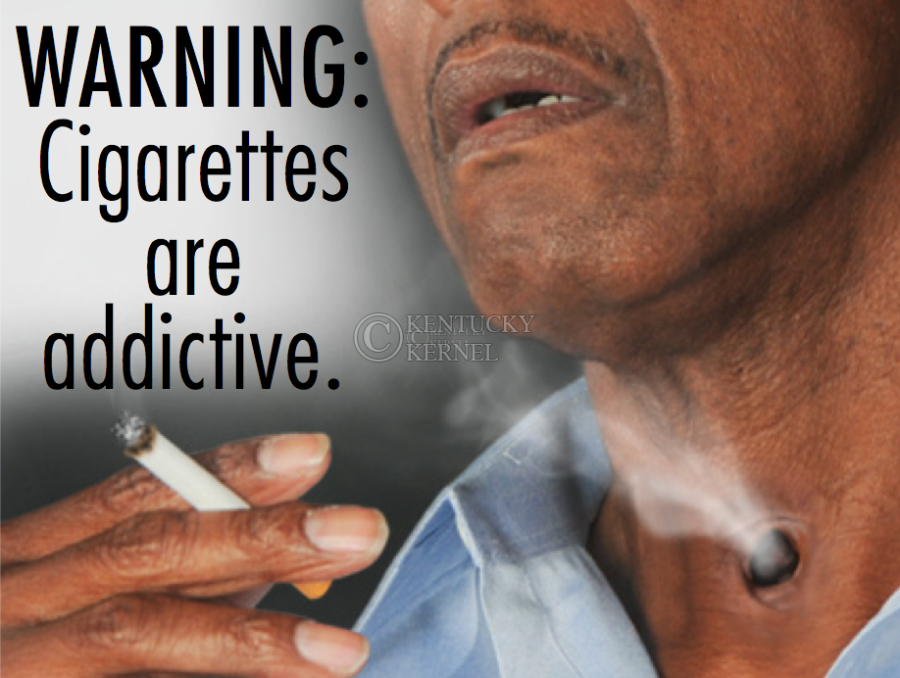‘Diseased lungs, dead bodies’ to be on cigarettes
November 19, 2010
A mother blowing smoke in a baby’s face, diseased lungs, dead bodies and cemeteries. These may now be some of the images people see when they pick up a pack of cigarettes.
The U.S. Food and Drug Administration issued a proposal for new graphic labels last week and will select nine from 96 potential labels to rotate on cigarette packing, said Audrey Darville, nurse practitioner and certified tobacco treatment specialist with UK HealthCare.
Graphic labels have been in place on cigarette packages in Canada, Egypt, Australia, New Zealand and countries in the European Union for years, Darville said.
Darville said some countries such as Australia and New Zealand have tobacco cessation hotline numbers listed on the cigarette packs in addition to the graphic images.
She said a study in New Zealand showed putting graphic labels with hotline information dramatically increased the number of calls the hotline received.
Darville said the North American Quitline Consortium is working to get its phone number put onto the new labels.
The new FDA labels will have three main themes, Darville said. The themes are pregnant women smoking, secondhand smoking around children and tobacco-exposure related illnesses.
Different images will be chosen to use and then rotated because people start to ignore the same messages, Darville said.
People can vote for their favorite label online until Jan. 11, 2011.
Darville said the labels came out of the Family Smoking Prevention and Tobacco Control Act and are mandated to go into effect by September 2012.
Kinesiology freshman Taylor Darst does not smoke and said she found the labels with pictures of babies to be the most effective.
Accounting freshman Elizabeth Rousos also does not smoke and said the pictures of the tombstones were also effective.
“Seeing the pictures rather than words would evoke more emotion,” Rousos said.
Fadyia Lowe, health education coordinator and tobacco treatment specialist with the University Health Service, said research shows one-third of students start smoking in college.
Fifty percent of people who start smoking in college will smoke after college, and 45 percent of college students have used tobacco in the last year, Lowe said.
Research shows scare tactics like labels don’t work to keep people from smoking, Lowe said, but they may prevent people from starting to smoke.
“The goal is to get (people) to not start smoking,” Lowe said.
Darst said she thought the labels would do more to bring awareness to the consequences of smoking, but she said most smokers already know the effects.
“I don’t know how much those are going to help,” Darst said. “But it’s worth a try.”
Erik Marise is a UK dining service worker at Blazer Cafe who smokes one to two cigarettes a day. Marise had not seen the labels, but said he thought the listed information may be more effective.
“Facts would be most important to tell you what you want,” Marise said.
Architecture sophomore Jeff Nelson smokes and had not seen the labels, but he said they may not help as much as providing information for how to access a website with people’s personal stories about smoking.
Tobacco Policy Research Program Director Ellen Hahn said the labels are to show people the effects of smoking.
“Anything that raises awareness is a good thing,” Hahn said.
She said smoking takes its toll quickly, and many people tell her they wish they had never started.
Still, Darville said the labels are not designed to dictate people’s actions.
“It’s not meant to be a ‘big brother’ coming down and telling you what to do,” Darville said.
Hahn said it takes more than just warning labels to keep people from smoking. Other barriers must be moved, and policies must be put in place.
“(You have to) throw a lot of stuff at this problem,” Hahn said. “(There’s) not one Band-Aid that’s going to fix it.”






























































































































































